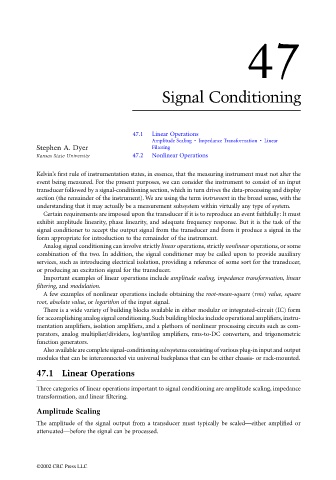Page 1194 - The Mechatronics Handbook
P. 1194
47
Signal Conditioning
47.1 Linear Operations
Amplitude Scaling • Impedance Transformation • Linear
Stephen A. Dyer Filtering
Kansas State University 47.2 Nonlinear Operations
Kelvin’s first rule of instrumentation states, in essence, that the measuring instrument must not alter the
event being measured. For the present purposes, we can consider the instrument to consist of an input
transducer followed by a signal-conditioning section, which in turn drives the data-processing and display
section (the remainder of the instrument). We are using the term instrument in the broad sense, with the
understanding that it may actually be a measurement subsystem within virtually any type of system.
Certain requirements are imposed upon the transducer if it is to reproduce an event faithfully: It must
exhibit amplitude linearity, phase linearity, and adequate frequency response. But it is the task of the
signal conditioner to accept the output signal from the transducer and from it produce a signal in the
form appropriate for introduction to the remainder of the instrument.
Analog signal conditioning can involve strictly linear operations, strictly nonlinear operations, or some
combination of the two. In addition, the signal conditioner may be called upon to provide auxiliary
services, such as introducing electrical isolation, providing a reference of some sort for the transducer,
or producing an excitation signal for the transducer.
Important examples of linear operations include amplitude scaling, impedance transformation, linear
filtering, and modulation.
A few examples of nonlinear operations include obtaining the root-mean-square (rms) value, square
root, absolute value, or logarithm of the input signal.
There is a wide variety of building blocks available in either modular or integrated-circuit (IC) form
for accomplishing analog signal conditioning. Such building blocks include operational amplifiers, instru-
mentation amplifiers, isolation amplifiers, and a plethora of nonlinear processing circuits such as com-
parators, analog multiplier/dividers, log/antilog amplifiers, rms-to-DC converters, and trigonometric
function generators.
Also available are complete signal-conditioning subsystems consisting of various plug-in input and output
modules that can be interconnected via universal backplanes that can be either chassis- or rack-mounted.
47.1 Linear Operations
Three categories of linear operations important to signal conditioning are amplitude scaling, impedance
transformation, and linear filtering.
Amplitude Scaling
The amplitude of the signal output from a transducer must typically be scaled—either amplified or
attenuated—before the signal can be processed.
©2002 CRC Press LLC

